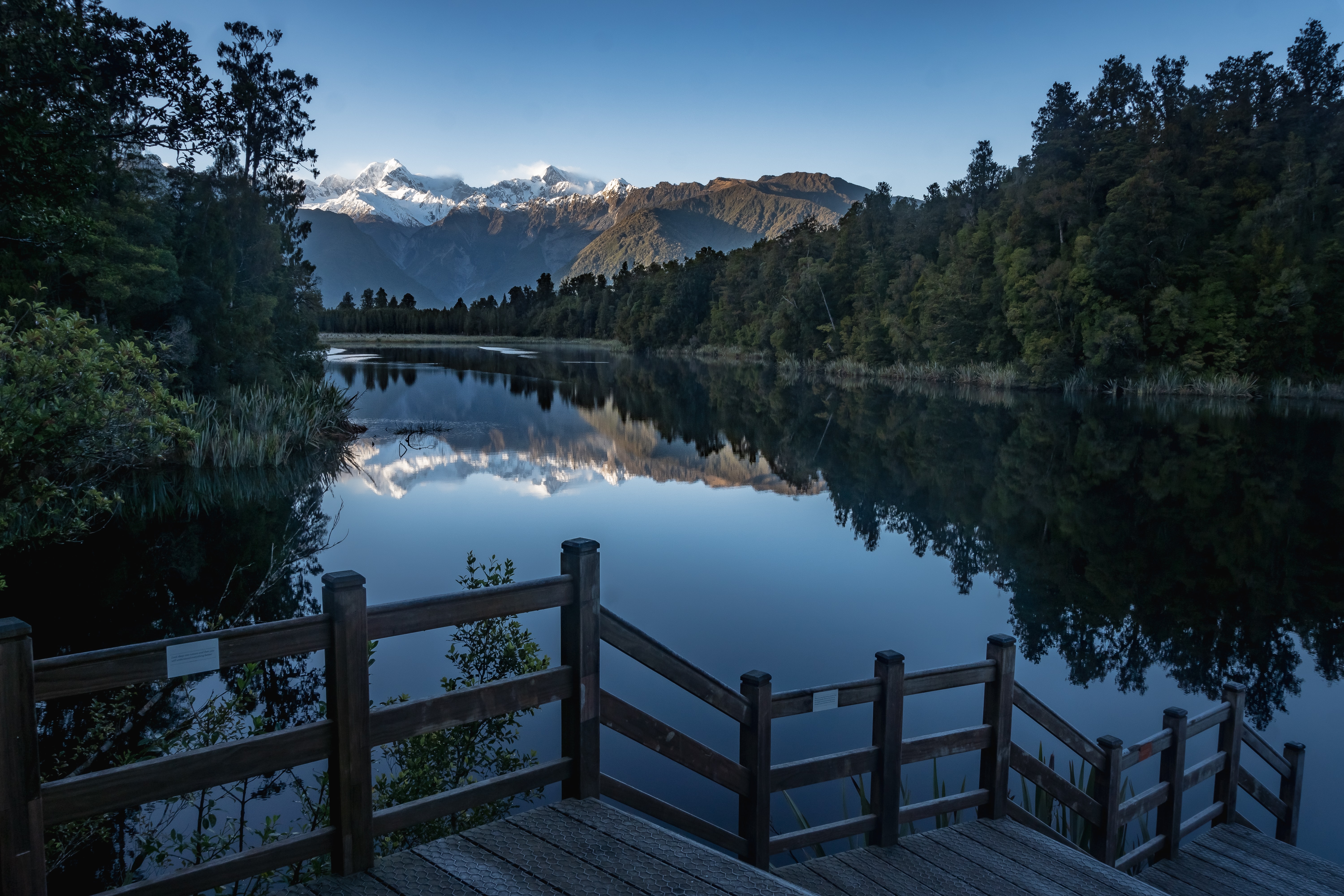Whangarei
17.89°C

Whangarei
17.89°C

Waitakere City
16.98°C

Manukau City
17.11°C

Papakura
24.46°C

Hauraki
17.26°C

Waikato
17.67°C

Matamata
18.46°C

Hamilton
17.51°C

Otorohanga
18.52°C

Rotorua
16.6°C

Taupo
15.44°C

Tauranga
19.27°C

Kawerau
18.6°C

Whakatane
19.64°C

Gisborne
15.51°C

New Plymouth
16.98°C

Stratford
8.97°C

Ruapehu
14°C

Wanganui
17°C

Palmerston North
16.41°C

Wairoa
19.19°C

Hastings
18.84°C

Napier
18.49°C

Masterton
15.49°C

Carterton
15.66°C

Porirua
15.99°C

Lower Hutt
16.45°C

Wellington
15.79°C

Tasman
9.35°C

Nelson
16.27°C

Marlborough
3.22°C

Kaikoura
15.48°C

Christchurch
12.59°C

Ashburton
12.52°C

Timaru
13.37°C

Waitaki
11.32°C

Waimate
13.08°C

Queenstown
12.38°C

Dunedin
14.33°C

Southland
9.98°C

Gore
11.31°C

Invercargill
12.06°C

Blenheim
14.73°C

Te Anau
27.35°C

Wanaka
11.17°C

Kaikoura
13.38°C

Stratford
13.54°C

Upper Hutt
15.9°C

About
The drive from Wanaka to the West Coast passes through spectacular scenery. This route was a traditional pathway for Maori journeying west in search of pounamu (greenstone or jade). The basins that are filled by Lake Hawea and Lake Wanaka were gouged out by the Hawea and Wanaka Glaciers. Two arms of the glaciers joined at a narrow piece of land called The Neck.
Makarora, at the northern tip of Lake Wanaka, is a launching point for several multi-day walks in Mount Aspiring National Park. A number of shorter walks begin at the highway's edge between Makarora to Haast. Favourites include walks to the Blue Pools, Fantail Falls, Thunder Creek Falls and Roaring Billy. At the Gates of Haast gorge, many travellers stop to photograph the wild water as it crashes over the river boulders.
The Maori name for the trail that leads through Haast Pass is Tiora-patea, which means 'the way is clear'. A gold prospector called Charles Cameron is believed to be the first European to find the pass. He crossed over in January 1863, burying his powder flask to the west of the pass. Close behind him came Julius von Haast, who named the pass after himself and claimed to be the first European to have travelled through it, however the discovery of Cameron's flask discredited this claim.
A gentle walk leads to views of the mountains reflected on the still waters of Lake Matheson. It's one of our best short walks.
Lake Matheson is nestled in ancient forest and is famous for mirror views of Aoraki/Mount Cook and Mount Tasman. Its excellent reflecting properties are due to the dark brown colour of the water – the result of organic matter leached from the humus of the forest floor. Dawn and dusk are the best times to enjoy the reflections in the lake.
Time: 45 min return car park to jetty
Distance: 2.4 km return car park to jetty
The first section of the walk, to the Jetty Viewpoint, is suitable for assisted wheelchairs. After crossing the Clearwater suspension bridge, the walk to the Jetty Viewpoint takes you past tall kahikatea and rimu as well as a rich profusion of smaller plant varieties.
The jetty provides a magnificent mountain view reflected in the dark waters.
Time: 1 hr 30 min return
Distance: 4.4 km return
After walking to the Jetty Viewpoint, continue further around the lake. You will find a similarly magnificent mountain reflection shrouded in native foliage at the View of Views at the top end of the lake, and again at Reflection Island.
Lake Matheson was formed when Fox Glacier Te Moeka o Tuawe retreated from its last significant advance about 14,000 years ago. During the last major ice age, the glacier spread across the coastal plains towards the sea, dumping huge piles of rock. The glacier ground a depression which later filled with water, forming the lake.
The species most likely to be seen here is the long-finned eel, which made this an important food gathering site (mahinga kai) for Māori travelling along the coast.
Ensure you take:
Walk past a waterfall along the wide river stone track, suitable for children. You can’t get that close to the glacier face anymore because it’s receded too far. After you’ve finished your walk, why not relax in the main hot pools at Franz Josef Glacier Hot Pools. Or even better, take a soak in the Franz Josef Glacier Private Hot Pools. The hot pools even have a Private Pamper Package!
If you’d prefer to have a guide take you and explain all about the glacier, discover the legends and history, learn all about the flora and fauna along the way, then book a3 hour guided valley walk to Franz Josef Glacier.This tour doesn’t go on the ice.
Fox Glacier is a beautiful yet volatile place – do not let the serene scene fool you. The glacier is constantly moving. Rocks and ice can fall from the terminal face without warning and creeks may rise quickly. Take extreme care and stay behind safety barriers.
For the first 100 metres of the track you will pass large mounds of moraine that cover 'dead ice' left behind when the glacier retreated in the 1960s.
From there, the track travels past the landslip zone (do not stop in this area) and on towards the glacier, crossing several small creeks along the way.
The track comes within 500 metres of the glacier's terminal face, a short climb takes you up to the viewing area.
Blowholes form from a mixture of compressed water and air escaping through the caverns below and being forced upwards, creating a huge wall of spray. They are at their best around high tide when there is a south-westerly swell.
Spectacular views, geological oddities, coastal forest, rich birdlife and marine mammals are highlights along this walk.
This national park is known for its "glacier country". In some places, huge tongues of ice extend all the way back down to near sea level. 3000m peaks tower over lowland rainforests that reach all the way to the edge of the Tasman Sea. It's an area also blessed with contrasting tussock grasslands, coast, lakes, rivers and wetlands.
Embark on kayaking adventures on Lakes Matheson and Mapourika and explore vast rivers and coastal lagoons. Take an easy walk to the base of the fascinating Fox and Franz Josef glaciers and look for some of New Zealand’s rarest native birds in the rainforests and wetlands.
The mountains of the Southern Alps are revered by the local Maori people (the Ngai Tahu tribe) as their ancestors. The whole coastal environment is also of considerable importance to these people, both spiritually and for the food and resources it provides.
Follow the track over the Clearwater suspension bridge, pass tall kahikatea and rimu to the jetty viewpoint. Here you will be greeted by magnificent mountain views reflected in the dark waters.
Lake Matheson is famous for its stunning mirror-like reflections, which are the result of leaf matter leaching into the water and turning it a dark brown colour.
As you leave the jetty and begin to circle the lake, you will come across numerous reflections shrouded in native foliage. Stop at the top end of the lake, and again at Reflection Island, to catch some of the most spectacular views.
Along the way, look out for eels. The long-finned eel is the most common species here and can sometimes be spotted breaking the tranquil surface of the lake.
The Haast region is so spectacular UNESCO awarded it the status of being a "World Heritage" area.
From Haast to Jackson Bay there are spectacular beaches, dunes, lakes and wetlands. This region is perfect for hunting and tramping and there are many Department of Conservation walks in the area for you to explore. People come here not only for the scenery but also for hunting and tramping. Activities include unique Jet Boat tours and helicopter flights.
Everywhere you look, Westland rainforest tumbles across the landscape. Haast entertainments include river safaris, visits to fur seal and penguin colonies, sea fishing, trout fishing, hunting and the drive to Jackson Bay, one of the most remote villages in New Zealand.
Of all the Great Walks, the Heaphy Track delivers the strongest contrasts. Every section of the track is vastly different from the previous one. Choose to hike this track and you’ll get luxuriant rainforest; sub-alpine tussock grasslands; high, rugged mountains; and, finally, lowland forest and palm-fringed surf beaches. You’re in for 82 kilometres of hard walking, but the frequent scenery changes will certainly take your mind off sore feet.
The track is staged within the Kahurangi National Park, the second largest national park in the country and home to many Great Spotted Kiwi Birds. Even to a non-geologist, Kahurangi’s rocks are deeply interesting. Parts of the region are limestone or marble; these areas are characterised by an abundance of caves, bluffs, natural arches, sinkholes and water-worn outcrops. The park also contains the largest cave system in New Zealand.
The path followed by the Heaphy Track was first used by Maori pounamu hunters travelling from Golden Bay to the pounamu (jade) rivers of Westland. Pounamu was highly valued for tools, weapons and ornaments.
In the Maori language, Kahurangi means 'treasured possession', a clue to the attractions of New Zealand's second largest national park. Within its boundaries lie some of the oldest rocks, strangest plants and rarest birds in the country.
While much of the park is untracked wilderness, other areas are laced with a network of walking tracks that allow you to explore high plateaux and coastal palm forests. The Heaphy Track is the park’s most famous and accessible treasure, followed by more than 4000 walkers each year. A ‘Great Walk’ by every definition, the track covers 78km of subtropical rainforest, tussock high country, river valley and coast. For hundreds of years the route was used by local Maori tribes on their way to the pounamu (greenstone) resources of the west coast.
Ōkārito is a small coastal settlement on the West Coast of New Zealand's South Island, 127 kilometres southwest of Hokitika, and 10 kilometres from State Highway 6. It is built at the southern end of the Ōkārito Lagoon at the mouth of the Ōkārito River.
The township is an old gold-mining area and has preserved much of its heritage with the Wharf Shed and Donovan's Store buildings fully restored by the local community. The long sand spit here is a wildly beautiful place where travelers can fully revel in the remote and lonely raw beauty of New Zealand's West Coast.
The Hokitika Gorge is one detour you won’t regret taking. You’ll be teased with glimpses of the otherworldly colour of the water through the trees as you make your way along the track. This is an easy walk through lush native bush to a rocky gorge with calm turquoise blue water caused by hard work high in the mountains where rocks are ground into a fine powder by the movement of glaciers.
Hokitika Gorge is a short walk from the car park through a mainly rimu and podocarp forest to a viewing platform where the water has to be seen to be believed.
An awesome viewing platform is just 4 minutes from the car park and this part of the track is accessible for wheelchairs.
Carry on further to an impressive swing bridge and the granite rocks of the gorge's walls.
For good views further up the gorge, cross the swing bridge and when you come to the end, turn left (straight ahead leads to private farmland).
The track continues for another 200m through the bush to another viewing platform with looking out to the gorge upstream of the bridge
The Callery Gorge walk is an easy 1 hr & 20min walk from the start and you double back again along the same track. The track follows the old sluice pipes laid by the Waiho Sluicing Company in 1912. Callery was the first person to find gold in Franz Josef in 1868. The track quality is very good, from the cul-de-sac in Cowan Street to the Franz Josef water works, it is a gravel service road used almost every day. From there to the site of the Waiho Sluicing Company, again is a good stone surface you can drive your car over. The descent down to Callery Gorge is a very good bush walking track with a hard surface and no water to walk through. Light running shoes will suffice.
Lake wombat is an easy interesting forest walk that will take you around 1 hr & 30 mins.
Some people would call it a tarn not a lake that sits below Alex Knob, 1300 mt. This lake was formed 9,000 years ago by the Franz Josef Glacier.
Kim from the Franz Josef DOC had this to say about the walk “I’m really pleased that you have included the Lake Wombat track in your listings, that is one of my favourite walks in the area and it is often overlooked! The bird life and flora are incredible on that track. I’m quite excited, the Easter Orchids will be starting to bloom soon and there is some fantastic spots on the Lake Wombat track where there are heaps of them, so it is a real feast for the senses (they smell like vanilla!). see an abundance of bird life on the Lake Wombat walk. The song of the Bellbird & Tui, filled the bush and the grey Warbler and the friendly Fantail fluttered around my head looking for insects.
Following the historic bush tramway through the lower Ngakawau Gorge and the Charming Creek valley to the abandoned Charming Creek Coal Mine, passing historic sawmilling and mining remains. The gorge nestles among steep bluffs while below, water foams past immense boulders in the riverbed.
Walk through bush lined corridors, past foaming rapids, and over historic railway formations.
A seal colony, a lighthouse and panoramic views of mountains and coastline feature on this spectacular coastal walkway. With the beach close by as well it's a good option for children. It's also one of our best short walks.
Cape Foulwind is a prominent headland on the West Coast of New Zealand's South Island, overlooking the Tasman Sea. It is located 16 kilometres west of the town of Westport.
It was previously named Rocky Cape by Abel Tasman, the first European to visit it, in 1642. In 1770 it was named Cape Foulwind by Captain James Cook after his vessel was blown off course by the prevailing westerly winds.
Try this 0.97 km, out and back trail near Whataroa, West Coast. Generally considered an easy route, it takes an average of 15 min to complete. This is a popular trail for hiking, walking, and other nature trips, but you can still enjoy some solitude during quieter times of day. The trail is open year-round and is beautiful to visit anytime.
The latest east-west development was the Otira Viaduct, which was officially opened in 1999. This impressive engineering feat soars above the steep gorge and tight zig-zags of the old road. Call into the viaduct lookout at ‘Deaths Corner’ to see the old and new roads and learn of their history. Kea—our mischievous mountain parrot—will no doubt be waiting at this lookout to check out you and your car. Cute and friendly as they are, don’t feed them unless you really want to make them sick or even kill them—in which case you could well be prosecuted for intentionally harming protected wildlife.
Beneath New Zealand's rugged landscapes lies a hidden world of unparalleled beauty, and Te Ananui Cave is a dazzling testament to this subterranean wonderland. Located on the North Island, this mystical cave system beckons adventurers and nature enthusiasts into its depths.
As you venture deeper into Te Ananui Cave, you'll be captivated by the mesmerizing glowworm displays that adorn its ceilings. These bioluminescent creatures create a celestial panorama, reminiscent of a starlit night sky. It's a breathtaking natural light show that seems almost otherworldly.
The cave's formations, sculpted over millennia by the gentle drip of water, showcase intricate stalactites and stalagmites. Glistening with mineral deposits, they paint a vivid picture of the Earth's artistic prowess.
Te Ananui Cave offers a unique underground adventure, with experienced guides leading you through its chambers, sharing the cave's rich history and geological significance. The journey is not just educational but also awe-inspiring.
Above ground, the cave's entrance is nestled within lush rainforest, making it a haven for birdwatchers and nature lovers. The experience of Te Ananui Cave is a remarkable blend of scientific wonder and natural beauty, inviting all who enter to marvel at the wonders hidden beneath the Earth's surface.
Prepare to be spellbound as you delve into Te Ananui Cave's mystical depths, where nature's secrets are illuminated in a world of enchanting darkness.